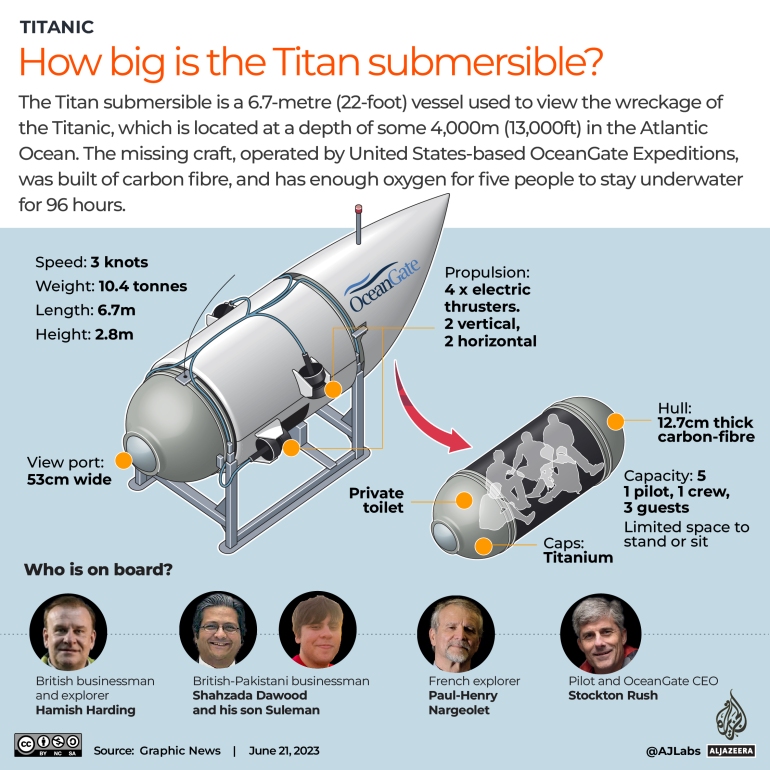The vessel, named Titan, lost communication with tour operators on Sunday while about 700km (435 miles) south of St John’s, Newfoundland, during a voyage to the Titanic shipwreck off the coast of Canada.
Here is what we know so far:
How much oxygen might there be left?
The 6.7-metre-long OceanGate Expeditions vessel began its descent at 8am (12:00 GMT) on Sunday.
Considering that it had a 96-hour air supply from the time it is sealed, according to its specifications, the US Coast Guard estimated oxygen in the submersible would have run out at about 10:00 GMT on Thursday.
This can vary depending on a few factors, such as whether the sub still has power in the icy depths.

What are the latest developments in the search mission?
The area of the search has been expanded, with the surface search now about 26,000 square kilometres, and the sub-surface search about four kilometres deep.
One of the vessels sent to help search efforts is the French research ship L’Atalante which carries a remotely operated vehicle (ROV), Victor 6000.
This ROV has a capacity to descend to 6,000 metres and it is connected to its parent ship with a cable eight kilometres (4.9 miles) long. The ship’s operator Oceanographic Fleet, says Victor can undertake video and acoustic search and inspection and has robotic arms that can manipulate objects.
The United States Coast Guard had five surface vessels searching for Titan on Wednesday and expected there to be 10 by Thursday, Jamie Frederick, captain of the First Coast Guard District, said on Wednesday.

Who else is participating in the search?
The Canadian research icebreaker Polar Prince, which was supporting the Titan, was conducting surface searches with help from a Canadian Boeing P-8 Poseidon reconnaissance aircraft, and the Canadian military dropped sonar buoys to listen for any possible sounds from the Titan.
Two US Lockheed C-130 Hercules aircraft were conducting overflights, and three C-17s from US Air Mobility Command have also been used to move another commercial company’s submersible and support equipment from Buffalo, New York, to St John’s to aid in the search.
A Royal Canadian Navy ship that provides a medical team specialising in dive medicine and a six-person mobile hyperbaric recompression chamber also was en route on Tuesday.
Magellan, a company specialising in deep sea rescue, is also deploying its ROV which can go as deep as 6,000 metres (3.7 miles)
What were the noises reported earlier?
Underwater noises were heard on Tuesday and again on Wednesday, although experts have been unable to determine the cause of the sound.
“With respect to the noises specifically, we don’t know what they are,” Frederick said on Wednesday, adding that analysis of the sonar buoy data was “inconclusive”.

What are the possible conditions out at sea?
The area of the North Atlantic where the Titan lost contact is also prone to fog and stormy conditions, making it an extremely challenging environment to conduct a search and rescue mission, said Donald Murphy, an oceanographer who served as chief scientist of the Coast Guard’s International Ice Patrol.
Who is on the submersible?
Pakistani and British nationals Shahzada Dawood and his son Suleman, British adventurer Hamish Harding, OceanGate’s chief executive and founder Stockton Rush and French explorer Paul-Henri Nargeolet, are reportedly in the Titan.
How deep are they?
The Titan is believed to be about 1,450km (900 miles) east and 640km south of Newfoundland.
It is not known how deep the vessel is, with the seabed about 3,800 metres from the surface.

You must be logged in to post a comment.